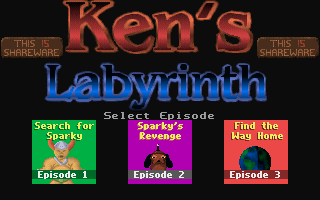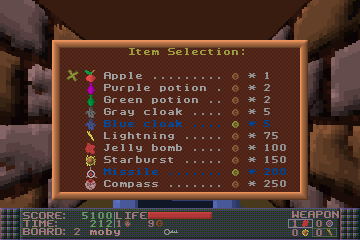Retro Replay Review
Gameplay
Ken’s Labyrinth delivers an engaging first-person shooter experience that closely echoes the classic roots of the genre. You guide the protagonist through a series of maze-like corridors, dispatching a variety of monsters with an arsenal of quirky weapons—most notably the bubble-gum gun, which offers both comic relief and surprising firepower. Each level is designed with multiple branching routes, secret alcoves, and hidden switches, encouraging players to explore every nook and cranny in pursuit of keys, health items, and ammunition.
(HEY YOU!! We hope you enjoy! We try not to run ads. So basically, this is a very expensive hobby running this site. Please consider joining us for updates, forums, and more. Network w/ us to make some cash or friends while retro gaming, and you can win some free retro games for posting. Okay, carry on 👍)
One of the standout gameplay features is the interactive environment. Vending machines, slot machines, and even arcade cabinets are scattered throughout the labyrinth, allowing you to spend in-game coins on power-ups or click your luck at mini gambling sequences. Breakable walls add another layer of excitement, rewarding observant players with shortcuts or hidden loot. These elements not only diversify the pacing but also inject moments of lighthearted fun between tense combat encounters.
Puzzle elements are woven organically into each level’s layout. Rather than static key-and-door chores, you’ll frequently backtrack to activate switches, open hidden passages, or lure enemies into ambushes. While the action remains the primary focus, these mild brain-teasers foster a satisfying sense of progression. For those craving additional challenge, speedrunners will appreciate the multiple routes and exploitation of breakable walls to shave precious seconds off their times.
Graphics
Visually, Ken’s Labyrinth employs a color-rich palette that stands out among its early ’90s peers. The game engine, while primitive by modern standards, uses bright, high-contrast textures that ensure each corridor feels distinct. From rusted metal walls to shimmering pools of toxic goo, the environmental variety keeps exploration fresh and helps you quickly orient yourself in the labyrinth’s maze of passageways.
Enemy design is both whimsical and grotesque. Demonic imps, spinning eyeballs, and other bizarre creatures are rendered with enough detail to be memorable, despite the low resolution. Their animations are simple yet effective—enough to telegraph attacks and inject personality into each encounter. Weapon sprites also receive thoughtful attention; flicking bubble gum and spitting flames feel dynamic in the midst of frantic firefights.
Performance-wise, Ken’s Labyrinth runs smoothly on modern hardware thanks to source ports and community patches. Frame rates remain stable even in crowded rooms, and load times are negligible. While there’s no true 3D geometry—walls and floors are flat, grid-based constructs—the strategic use of sloped floors and transparent textures adds a surprising sense of verticality to certain areas.
Story
At its core, Ken’s Labyrinth spins a simple yet motivating tale: you are trapped in an underground complex teeming with monsters, and your beloved dog Sparky has been kidnapped. While the narrative is delivered sparingly—via text screens between episodes and minimal in-game hints—it provides enough emotional stakes to drive you forward. The promise of reuniting with Sparky casts even the most menacing corridors in a personal light.
The writing leans into tongue-in-cheek humor, balancing horror tropes with playful asides. NPC messages scrawled on graffiti-laden walls or whispered over dusty PA systems hint at the labyrinth’s dark history, while vending machine brand names and slot machine jingles underline the game’s cheeky tone. Although there are no voiced cutscenes, the sparse dialogue and environmental storytelling are surprisingly effective at building atmosphere.
For players who crave deeper lore, the manual and bundled text files expand on the backstory, describing the labyrinth’s enigmatic creator (Ken) and his bizarre experiments. These extras cast a new light on the level design—suddenly the odd vending machines and blood-stained corridors aren’t just set dressing, but clues to the twisted mind behind it all. While not essential to enjoy the shooting action, they reward thorough fans with an extra layer of intrigue.
Overall Experience
Ken’s Labyrinth stands as a charming time capsule of early 3D shooter design. Its blend of fast-paced combat, maze exploration, and interactive trinkets offers a unique spin on the formula popularized by Wolfenstein 3D. Whether you’re rediscovering a retro gem or experiencing it for the first time, the game’s brisk pacing and inventive level design ensure that boredom is never an issue.
The game’s short length—six episodes of nine levels each—means you can tackle it in a single weekend if you’re determined. Replay value is boosted by hidden areas, multiple difficulty settings, and the community’s source-port enhancements, which bring improved controls and widescreen support. Even today, the absurdity of a bubble-gum gun remains a conversation starter among shooter aficionados.
While it lacks the narrative depth and graphical polish of modern titles, Ken’s Labyrinth delivers tightly focused, old-school fun. It’s an ideal purchase for retro enthusiasts, speedrunners, or anyone curious about the formative years of the FPS genre. With its quirky weapons, interactive touches, and memorable monster designs, it continues to carve out a special niche in gaming history—and resistance is truly futile for those seeking a blast from the past.
 Retro Replay Retro Replay gaming reviews, news, emulation, geek stuff and more!
Retro Replay Retro Replay gaming reviews, news, emulation, geek stuff and more!









Reviews
There are no reviews yet.